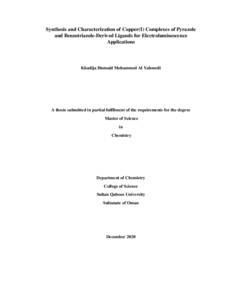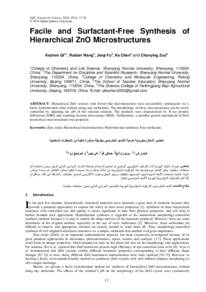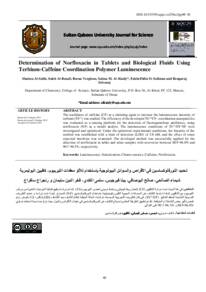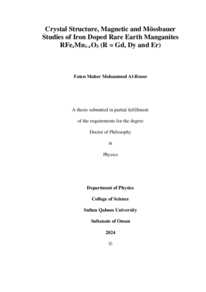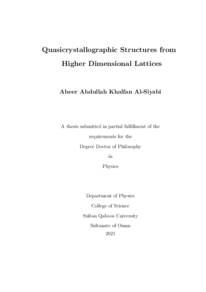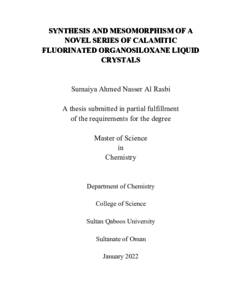Document
Synthesis and characterization of copper(I) complexes of pyrazole and benzotriazole-derived ligands for electroluminescence applications.
Publisher
Sultan Qaboos University.
Gregorian
2020
Language
English
English abstract
Three new bidentate imine ligands (N,N), namely 1-(1-pyrazolyl)isoquinoline (L1), 2-(1-
pyrazolyl)quinoline (L2) and 1-(2-pyridyl)benzotriazole (L3), were synthesized, isolated
and identified by elemental analyses and mass spectrometry. Subsequently, they were
characterized by infrared (IR), UV-visible and 1H-NMR spectroscopic techniques. Seven
copper(I) mononuclear complexes of these ligands were synthesized and characterized by
several physical techniques: five ionic complexes [Cu(L1)(xantphos)]PF6 (1),
[Cu(L1)(POP)]PF6·Et2O (2), [Cu(L2)(POP)]BF4 (4), [Cu(L3)(xantphos)]BF4 (5) and
[Cu(L3)(xantphos)]PF6 (6), and two molecular complexes [CuI(L2)(PPh3)]·CH2Cl2 (3)
and [CuBr(L3)(PPh3)2] (7) (where xantphos, POP and PPh3 are 1,1'-(9,9-dimethyl-9Hxanthene-4,5-diyl)bis[1,1-diphenylphosphine], bis[(2-diphenylphosphino)phenyl] ether
and triphenylphosphine, respectively). The ionic character of complexes 1, 2, 4, 5 and 6
was ascertained by electrical conductivity measurements, IR spectroscopy which revealed
the presence of the counter anions (PF6
–
and BF4
–
) and mass spectrometry which showed
parent peaks attributable to the [Cu(N,N)(P,P)]+
complex cations.
All seven complexes (1–7) were characterized by single-crystal X-ray crystallography.
Each of the structures of the ionic complexes 1, 2, 5 and 6 shows one complex cation and
one polyatomic anion; however, the crystallographic asymmetric unit of complex 4
exhibits two unique pairs of cations and polyatomic anions. Each complex cation consists
of a Cu(I) central atom coordinated to one bidentate imine ligand (N,N) and one bidentate
diphosphine ligands (P,P). Whereas the copper(I) center of the molecular complex
[CuI(L2)(PPh3)]·CH2Cl2 (3) is coordinated to one L2 ligand in a chelating mode, one PPh3
ligand and one iodide ion, in the other molecular complex [CuBr(L3)(PPh3)2] (7) the fourcoordinate geometry comprises a benzotriazole nitrogen of L3 (monodentate coordination
mode), two phosphorus atoms from two PPh3 ligands and one bromide ion. The
coordination geometries at the metal center are best described as distorted tetrahedral with
τ4 values in the range of 0.80–0.90, and the planarity of the bidentate N,N ligands ranges
from 6.11º (in complex 3) to 28.07º (in complex 1). All the ionic complexes participate in
extensive C-H···F H-bonding between the counter anions and the complex cations; all the
complexes except 3 and 4 also have π-π stacking intermolecular interactions and all except
1 exhibit C-H···π interactions.
The complexes were characterized by UV-visible spectroscopy in CH2Cl2 solution except
7, which could not be characterized due to its instability in solution. All complexes show
intense, high-energy intra-ligand bands; however, the nature of the weak low-energy
bands depends on the type of the complexes. The low-energy bands of the ionic complexes
are assignable to metal-to-ligand charge-transfer (MLCT) transitions whereas those of the
molecular complexes are associated with mixed halide/metal-to-ligand transitions
(X+M)LCT. TD-DFT calculations were conducted to investigate the nature of the frontier
orbitals of the complexes. It was found that the highest contribution to LUMO came from
the N,N chelating ligand but the HOMO had different contributions, based on the
complex type. The HOMO of the ionic complexes have highest contribution from Cu(I)
and the phosphine ligands while the HOMO of the molecular ones have mixed
contribution from Cu(I), halide and phosphine ligands. The energy gap between HOMO
and LUMO is lower for molecular complexes and their individual energies are less
positive compared to those of the ionic complexes. The emission spectra of the powdered
vii
complexes 1–7 were measured at room temperature. The ionic complexes and complex 7
emit green radiation in the 519–533 nm range while the molecular complex 3 emits yellow
radiation at 574 nm. The emission intensities of the complexes of L3 and complex 4 of
L2 are very high (515–811) while those of ligand L1 and complex 3 of L2 are low (90–
235). Finally, the emissions of the complexes are quenched in solution.
Member of
Resource URL
Category
Theses and Dissertations

